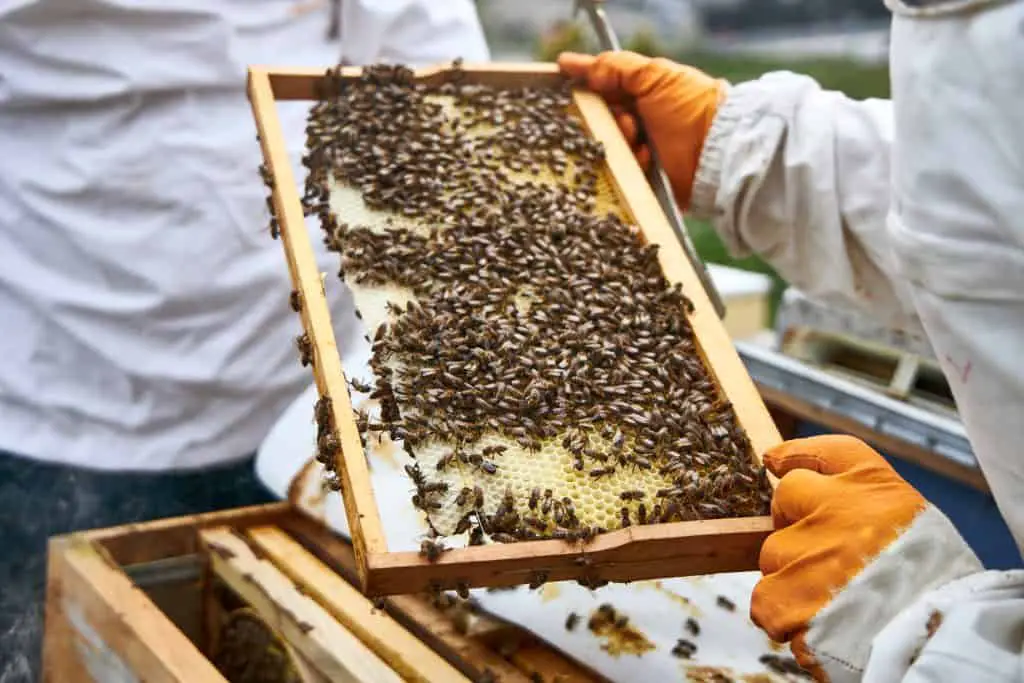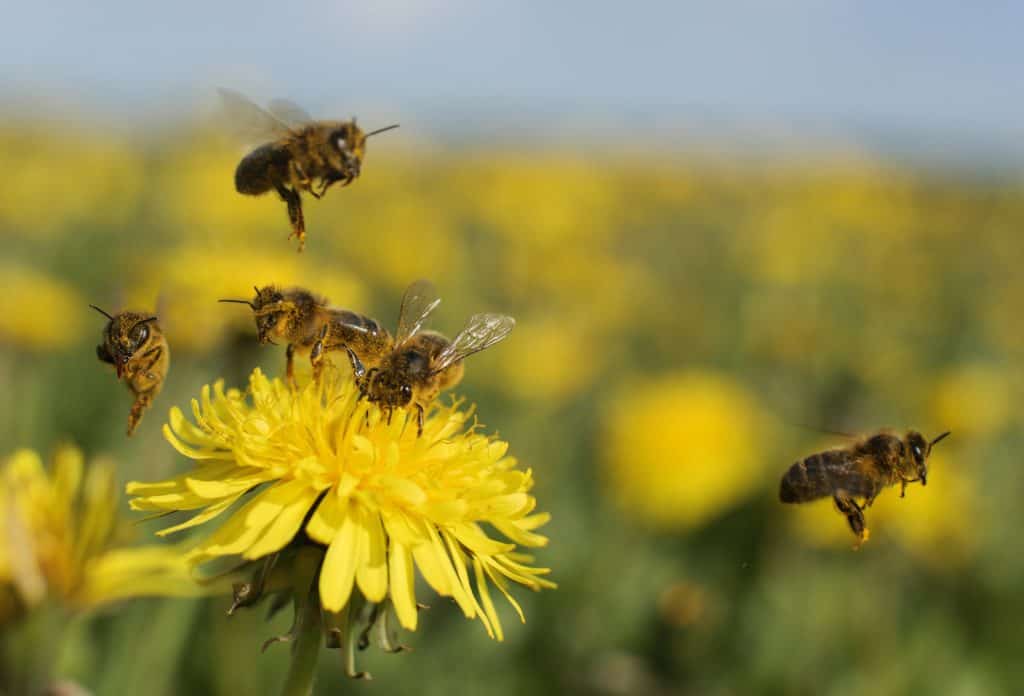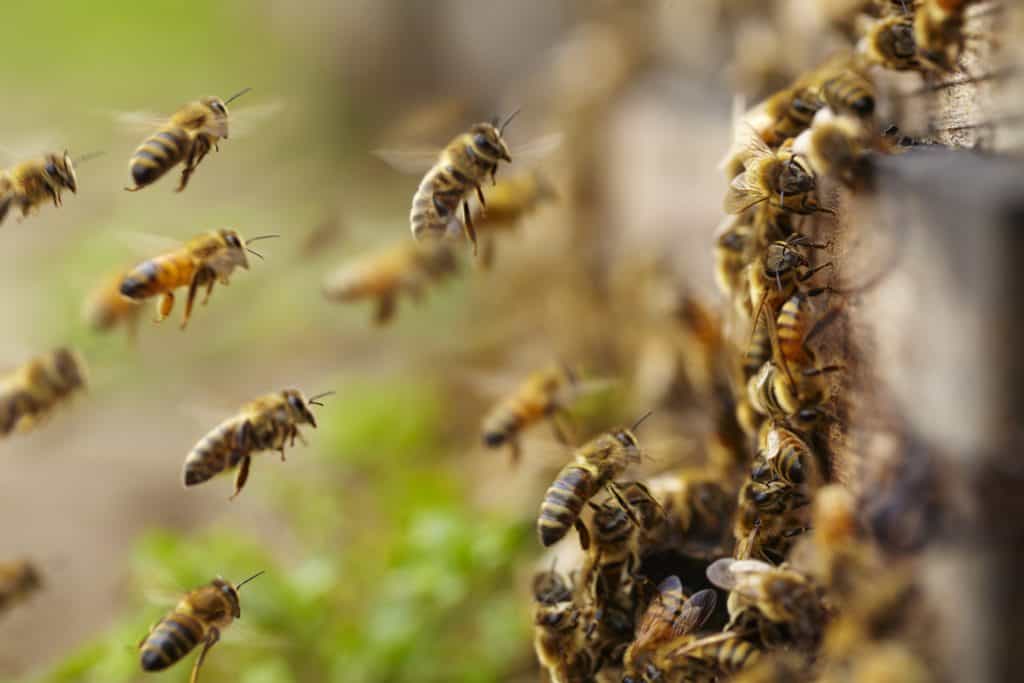Whether you’re a professional beekeeper or simply interested in bees, you may be wondering how much honey a hive of bees can produce. While there are many factors that affect the amount of honey that one hive can produce in a year, one colony of bees produced on average about fifty-five pounds of excess honey in 2019.
This number does not include the approximately ninety pounds of honey that bees need in order to survive winter, meaning that they produce more than one hundred pounds of honey per year. Beekeepers must leave at least ninety pounds of honey for the bees during the winter months, which means the yield of honey that can be harvested from a hive is much lower than the actual amount of honey produced.
How Much Honey Can One Frame Hold?

One deep frame within a Langstroth hive can hold about eight pounds of honey when it is filled with capped honeycomb. One medium frame full of honey holds about six pounds of honey. This means that one bee colony needs at least ten to twelve deep frames available to store their winter food supply, plus more to store additional honey they may produce.
What Factors Limit Honey Production?
There are many factors at play when discussing honey production. The most important factor is simply the population of honey bees. If the honey bee worker population is reduced for any reason, the honey yield will be much lower because there are fewer worker bees available to produce honey. The other major factors in honey yield are the availability of nectar and storage space for the honey.
Reduced Honey Bee Population
There are several reasons that a honey bee population might be reduced, including predators, parasites, colony collapse disorder, and the age and quality of the queen bee. These factors determine how much excess honey a colony can produce, and whether they can even produce enough honey to get them through the winter.
Predation and Parasites
Parasites such as Varroa mites or Tracheal mites and predators like skunks and bears play a big role in the population of a bee colony, and therefore their honey production.
Varroa Mites
Varroa mites are parasitic mites that live in honey bee colonies. While Varroa mites generally do not kill honey bees directly, they have several negative impacts on honey bees that makes them an important factor in honey bee population size.
Firstly, Varroa mites feed on the haemolymph of the bees, which is kind of like bee blood. During their developmental stages, the Varroa mites live in the brood cells with the bees and feed on their haemolymph. While this does not kill the bees directly, it reduces their body size as they develop into adults. This makes them weaker and less able to perform their honey-making activities.
Additionally, Varroa mites can pass viruses to bees, including the deformed wing virus. This virus in particular is very dangerous to bees, as it shrivels their wings and makes it impossible for them to fly. When bees cannot fly, they cannot perform their normal activities, making it difficult for them to produce honey.
Tracheal Mites
Tracheal mites are another type of parasite that impact honey bees negatively. They live within the respiratory system of adult bees, laying eggs and hatching all within the trachea of the bees.
Tracheal mites, like Varroa mites, cause severe damage to the honey bee’s ability to produce honey. Tracheal mites can make bees unable to fly, which reduces their capacity to collect the nectar necessary to create honey. These mites also lead to more bees staying in the hive rather than foraging, as they become sick and have difficulty breathing.
Predators
Predators such as bears and skunks who like to feed on honey and bee larvae also have a great impact on honey bee population. It is essential to protect bees from such predators because when a predator enters a hive to feed on the honey and bees, it greatly reduces the bees’ capacity to produce honey.
Colony Collapse Disorder
Colony collapse disorder is a somewhat mysterious phenomenon in which a colony loses many of its worker bees for unknown reasons. Because worker bees are responsible for making honey, a colony that is experiencing colony collapse disorder will have great difficulty producing enough honey to survive. Typically, colonies afflicted with colony collapse disorder do not survive very long.
Quality of the Queen
The quality of the queen and her egg laying abilities also have an impact on the worker bee population of a colony and their ability to produce honey. If a queen is aging or diseased, she may lay fewer eggs or lay eggs in a less organized way. This can lead to a smaller worker bee population, which means less honey produced.
Nectar Availability

Nectar availability is also a factor in honey production, as nectar is a major ingredient in honey. If nectar is not readily available, bees will struggle to produce large amounts of honey, and may even die during the winter.
Season and Weather
What time of year it is and the weather has a great impact on nectar availability for bees. Early in the spring when there are not many flowers blooming, bees have difficulty finding enough nectar to produce honey. Additionally, bees do not like to forage when it is colder than 55 degrees Fahrenheit, or when it is raining or windy. If there have been long periods of rain or wind, the bees may not be able to forage enough to produce large amounts of honey.
Distance from Flowers
How far a hive is from available flowers also has a great impact on whether bees can produce large amounts of honey. If flowers are located very far from the hive, the bees must spend more of their time flying to and from the flowers, rather than making honey. This reduces the bees’ capacity to create honey.
Hive Size
In addition to other factors, the size of the hive that bees are living in and storing their honey in has a great impact on honey production levels.
Storage Space for Honey
If bees do not have adequate space for honey storage, they will struggle to produce and store enough honey to get them through the winter, much less extra honey that can be harvested. Bees need at least ten to twelve deep frames per colony in which to store their winter honey supply, and if they are lacking storage space, they will have trouble surviving winter and will not produce as much honey as bees with larger hives.
Swarm Management
Related to hive space, swarming is another factor in honey production levels of a colony. Swarming occurs when a bee colony splits into two smaller colonies, usually caused by overcrowding in the hive. The new colony typically takes a while before it begins producing honey, meaning that when colonies swarm it reduces their honey production.
How Do You Increase Honey Production?
There are many ways to increase a colony’s honey production. Some of the most important are to ensure that your bees are healthy and well-fed, and have plenty of storage space for their honey.
Healthy Honey Bee Population

Maintaining a healthy honey bee population is the most important way to increase honey production. If your colonies are unhealthy or have high levels of parasites, they are less likely to produce large amounts of honey.
Management of Predators and Parasites
Regular testing and treatment for parasites such as Varroa mites and Tracheal mites is essential for maintaining a healthy colony that will produce a lot of honey. You should test for mites and other parasites at least three times per year, in the spring, summer, and fall, to ensure that you are aware of any infestations. Then, you can treat the infestations to prevent population loss and disease.
Prevention of Colony Collapse Disorder
It is also important to prevent colony collapse disorder, as this phenomenon results in much smaller colonies and ultimately, the loss of the colony as a whole. You can help prevent colony collapse disorder by generally keeping your bees healthy and not stressed out. This means providing food when nectar is scarce, checking regularly for mites, and giving your bees adequate ventilation.
Requeening When Necessary and Appropriate
Another way to increase honey production is simply to requeen your colonies whenever the present queen becomes old or sick. Because colonies with old or sick queen bees have trouble producing enough worker bees to perform the daily activities of the hive, ensuring that there is a young, healthy queen present in each colony will help increase your bees’ honey yield.
Diverse and Available Food Sources
Another factor that you can control to a certain extent is how available food is for your bees. It is important that bees have access to adequate nectar and pollen to keep the colony healthy and enable them to make enough honey to survive.
Distance from Flowers
The first factor that you can control when it comes to your bees’ food sources is simply where you keep them. If you keep them in a location where flowers are scarce and they have to travel long distances to gather nectar and pollen, they will have trouble producing a lot of honey.
On the other hand, if you plant flowers close to your hives or make sure that there are lots of wildflowers near your hives, your bees will produce much more honey.
Supplemental Feeding
Additionally, you can feed your bees supplemental food when nectar and pollen are scarce. This is especially important in the early spring, when bees are coming out of their overwintering phase but there are not many flowers in bloom yet. Feeding bees sugar syrup is the easiest way to supplement their diet.
Adequate Storage Space for Honey
Another important factor in increasing your colony’s honey yield is to give them enough storage space for their honey. It is important to give each colony at least ten to twelve deep frames in which to store their honey and build beeswax combs.

